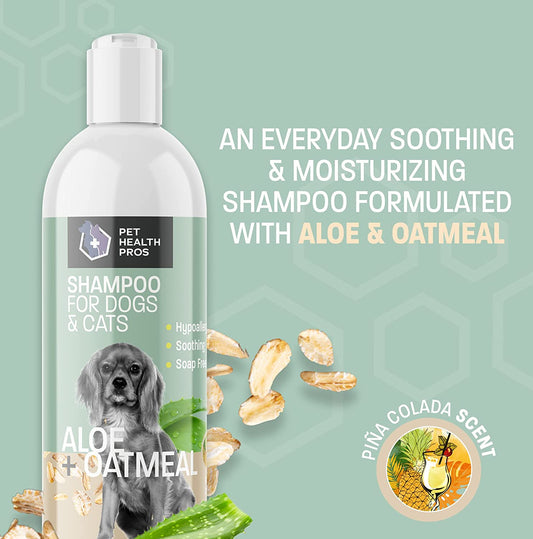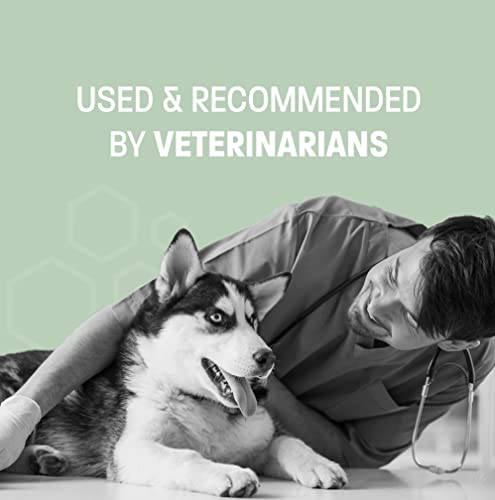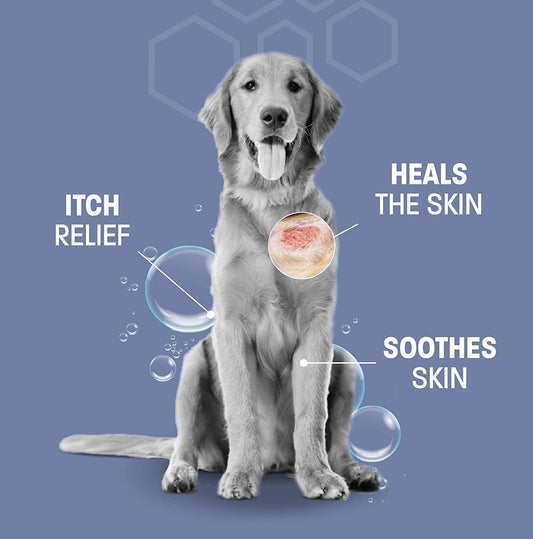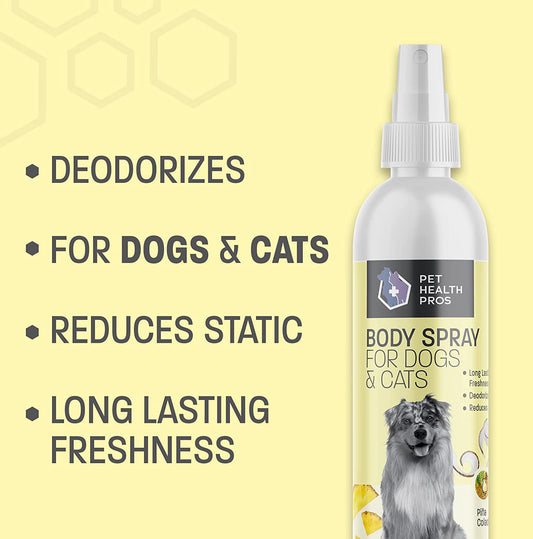Paw itching is a common problem that many dogs experience. It can be caused by various factors such as allergies, irritants, or underlying health conditions. If your dog is constantly scratching or licking their paws, it's important to address the issue to prevent further discomfort and potential complications. In this article, we will explore some tips for relieving paw itching in dogs and provide key takeaways to help you effectively manage this condition.
Key Takeaways
- Maintain proper paw hygiene to prevent and alleviate itching.
- Choose a dog shampoo that is gentle and suitable for your dog's skin.
- Avoid irritants and allergens that may trigger paw itching.
- Regular grooming and nail trimming can help prevent excessive scratching.
- If your dog's paw itching persists or worsens, seek veterinary care.
Understanding Paw Itching in Dogs
Causes of Paw Itching
Paw itching in dogs can be caused by a variety of factors. Allergies are a common cause of paw itching, with environmental allergens such as pollen, dust mites, and mold being the primary culprits. Food allergies can also lead to paw itching, often triggered by ingredients like beef, chicken, wheat, or soy. Additionally, contact allergies from substances like certain cleaning products or fabrics can irritate a dog's paws. Parasites such as fleas, ticks, or mites can also cause intense itching and discomfort. It's important to identify the underlying cause of paw itching to effectively address the issue.
Common Symptoms of Paw Itching
Paw itching in dogs can manifest in various ways. Some common symptoms include excessive licking or chewing of the paws, redness or inflammation, dry or flaky skin, and the presence of sores or lesions. Dogs may also exhibit signs of discomfort, such as limping or favoring one paw over the others. It's important to pay attention to these symptoms as they can indicate an underlying issue that needs to be addressed.
Identifying Allergies as a Cause
Allergies are one of the common causes of paw itching in dogs. Itchy Paws In Dogs: 5 Causes include allergies, paw yeast infections, dry paw pads, grass allergies, and dirty paw hygiene. Allergies can be triggered by various factors such as certain foods, environmental allergens like pollen or dust mites, or even contact with certain materials. When a dog is allergic to something, their immune system overreacts and releases histamines, leading to itching, redness, and inflammation. It is important to identify the specific allergen causing the reaction in order to effectively manage and prevent paw itching.
Other Potential Causes of Paw Itching
While allergies are a common cause of paw itching in dogs, there are other potential factors that can contribute to this uncomfortable condition. One possible cause is dry skin, which can be exacerbated by environmental factors such as low humidity or excessive bathing. Additionally, certain parasites like fleas or mites can also lead to paw itching. It's important to regularly check your dog for any signs of these pests and take appropriate measures to prevent infestations. Another potential cause of paw itching is contact dermatitis, which occurs when the skin comes into contact with irritants or allergens. This can include substances like certain cleaning products, plants, or even certain types of flooring.
Preventing Paw Itching
Maintaining Proper Paw Hygiene
Proper paw hygiene is essential for keeping your dog's paws healthy and free from irritation. Regular cleaning and maintenance can help prevent paw itching and discomfort. Here are some tips to maintain proper paw hygiene:
-
Keep the paws clean: Use a mild, pet-safe cleanser to gently wash your dog's paws. Be sure to remove any dirt, debris, or allergens that may be trapped between the paw pads.
-
Trim the nails: Long nails can cause discomfort and contribute to paw itching. Regularly trim your dog's nails to keep them at a comfortable length.
-
Moisturize the paws: Dry, cracked paws can be prone to itching. Apply a pet-safe moisturizer, such as coconut oil or paw balm, to keep the paws hydrated and prevent dryness.
-
Check for any signs of irritation: Regularly inspect your dog's paws for any redness, swelling, or signs of infection. If you notice any abnormalities, consult your veterinarian for further evaluation and treatment.
Choosing the Right Dog Shampoo
When it comes to choosing the right dog shampoo, it's important to consider your dog's specific needs. Anti-Fungal Dog Shampoo for Itchy Skin is a great option for dogs experiencing paw itching. This shampoo is specially formulated to help relieve itching and soothe irritated skin. It contains ingredients that target fungal infections and provide relief from itchiness. It is important to follow the instructions on the shampoo bottle and consult with your veterinarian if you have any concerns.
Avoiding Irritants and Allergens
To prevent paw itching in dogs, it is important to avoid irritants and allergens that can trigger allergic reactions. Common irritants and allergens include certain types of grass, pollen, dust mites, mold spores, and certain cleaning products. Here are some tips to help you avoid irritants and allergens:
- Keep your dog away from areas with high grass or weeds, especially during allergy season.
- Regularly clean and vacuum your home to reduce dust mites and mold spores.
- Use hypoallergenic cleaning products that are free of harsh chemicals.
- Wash your dog's bedding regularly to remove allergens.
- Avoid using scented products, such as perfumes or air fresheners, as they can irritate your dog's paws.
It is also important to note that some dogs may have specific food allergies that can contribute to paw itching. If you suspect your dog has a food allergy, consult with your veterinarian to determine the best diet for your dog.
Regular Grooming and Nail Trimming
Regular grooming and nail trimming are essential for maintaining your dog's paw health. Grooming helps to keep the fur around the paws clean and free from debris, reducing the risk of irritation and itching. It also allows you to inspect the paws for any signs of injury, infection, or foreign objects. Nail trimming is important to prevent overgrown nails, which can cause discomfort and affect your dog's gait. Proper nail trimming should be done carefully to avoid cutting the quick, which can be painful for your dog.
Home Remedies for Paw Itching
Oatmeal Soaks for Soothing Itchy Paws
Oatmeal soaks are a popular home remedy for soothing itchy paws in dogs. Oatmeal has natural anti-inflammatory properties that can help reduce itching and irritation. To prepare an oatmeal soak, grind plain, uncooked oatmeal into a fine powder and mix it with warm water to create a paste. Soak your dog's paws in the oatmeal mixture for about 10-15 minutes, gently massaging the paws to ensure the oatmeal reaches all the affected areas. Rinse the paws thoroughly with warm water and pat them dry. Repeat this process as needed to provide relief to your dog's itchy paws.
Coconut Oil as a Natural Moisturizer
Coconut oil is a popular natural remedy for relieving paw itching in dogs. According to integrative pet care expert Dr. Karen Becker, natural virgin coconut oil has antiviral, antibacterial, antimicrobial, and antiprotozoal properties[^404d]. These properties can help soothe irritated and itchy paws, providing relief for your furry friend. To use coconut oil as a moisturizer, simply apply a small amount to your dog's paws and gently massage it in. It's important to note that while coconut oil can be beneficial for most dogs, some may have allergies or sensitivities to it, so it's always best to consult with your veterinarian before trying any new remedies.
Apple Cider Vinegar Rinse for Yeast Infections
Yeast infections in dogs' paws can be uncomfortable and irritating. One natural remedy that can help alleviate the symptoms is an apple cider vinegar rinse. Apple cider vinegar has antifungal properties that can help combat the yeast overgrowth in the paws. To prepare the rinse, mix equal parts of apple cider vinegar and water. Soak your dog's paws in the solution for a few minutes, making sure to cover all the affected areas. Gently pat the paws dry afterward. Repeat this process a few times a week to help relieve the itching and discomfort caused by yeast infections.
Aloe Vera Gel for Cooling and Healing
Aloe vera gel is a popular natural remedy for cooling and healing itchy paws in dogs. The gel from the aloe vera plant has soothing properties that can help alleviate discomfort and reduce inflammation. Aloe vera contains various vitamins, minerals, and antioxidants that promote healing and moisturize the skin.
To use aloe vera gel for your dog's itchy paws, follow these steps:
- Obtain a pure and organic aloe vera gel without any added chemicals or fragrances.
- Clean your dog's paws with a mild, pet-safe cleanser and pat them dry.
- Apply a thin layer of aloe vera gel to the affected areas of your dog's paws.
- Gently massage the gel into the skin to ensure it is absorbed.
- Allow the gel to dry completely before your dog walks or licks their paws.
Remember to consult with your veterinarian before using aloe vera gel or any other home remedy on your dog's paws, especially if the itching persists or worsens. They can provide guidance and ensure the treatment is suitable for your dog's specific condition.
When to Seek Veterinary Care
Persistent or Worsening Symptoms
If your dog's paw itching persists or worsens despite home remedies and preventive measures, it may be time to seek veterinary care. Persistent itching can be a sign of an underlying health condition that requires professional attention. Your veterinarian will be able to assess your dog's symptoms and provide appropriate treatment options. They may recommend further diagnostic tests to determine the cause of the itching and develop a targeted treatment plan. It's important not to ignore persistent or worsening symptoms, as they can indicate a more serious issue that needs to be addressed.
Signs of Infection
Infections in a dog's paws can be a serious concern and should not be ignored. Redness, swelling, and warmth are common signs of infection. Additionally, if your dog is constantly licking or chewing their paws, it could be a sign of an underlying infection. Other signs include pus, odor, and limping. If you notice any of these symptoms, it is important to seek veterinary care as soon as possible.
Severe Paw Itching and Discomfort
Severe paw itching and discomfort in dogs can be a sign of underlying health conditions that require veterinary care. If your dog is experiencing persistent or worsening symptoms, it is important to seek professional help. Ignoring the problem can lead to further complications and discomfort for your furry friend.
If your dog is showing signs of infection such as redness, swelling, or discharge, it is crucial to consult with a veterinarian. Infections can occur as a result of excessive scratching and can lead to more serious issues if left untreated.
Proper paw hygiene is essential in preventing severe itching and discomfort. Regularly cleaning your dog's paws and keeping them dry can help reduce the risk of irritation and infection. Additionally, trimming your dog's nails regularly can prevent them from scratching excessively and causing further discomfort.
If your dog's paw itching and discomfort persist or worsen despite home remedies and proper hygiene, it is important to consult with a veterinarian. They can help identify any underlying health conditions that may be causing the symptoms and provide appropriate treatment.
Underlying Health Conditions
In some cases, paw itching in dogs may be a symptom of underlying health conditions. Allergies, such as food allergies or environmental allergies, can cause itching and irritation in the paws. Autoimmune diseases, such as pemphigus or systemic lupus erythematosus, can also lead to paw itching. Additionally, parasitic infections, such as mange or fleas, can cause intense itching and discomfort in the paws. If your dog's paw itching is persistent or accompanied by other symptoms, it is important to consult a veterinarian for proper diagnosis and treatment.
Conclusion
In conclusion, preventing and treating paw itching in dogs is essential for their overall well-being. By following these tips, such as maintaining proper hygiene, using natural remedies, and seeking veterinary advice when necessary, you can help alleviate your dog's discomfort and promote a healthy and happy life. Remember, a happy dog is a scratch-free dog!
Frequently Asked Questions
What are the common causes of paw itching in dogs?
Common causes of paw itching in dogs include allergies, irritants, infections, and underlying health conditions.
How can I prevent paw itching in my dog?
You can prevent paw itching in your dog by maintaining proper paw hygiene, using the right dog shampoo, avoiding irritants and allergens, and regularly grooming and trimming their nails.
Are there any home remedies for paw itching?
Yes, there are several home remedies for paw itching in dogs, including oatmeal soaks, coconut oil as a natural moisturizer, apple cider vinegar rinse for yeast infections, and aloe vera gel for cooling and healing.
When should I seek veterinary care for my dog's paw itching?
You should seek veterinary care for your dog's paw itching if the symptoms persist or worsen, if there are signs of infection, if your dog experiences severe paw itching and discomfort, or if there are underlying health conditions.
Can paw itching be a sign of allergies in dogs?
Yes, paw itching can be a sign of allergies in dogs. Allergies can cause itching and irritation in various parts of the body, including the paws.
What can I do if my dog's paw itching is due to allergies?
If your dog's paw itching is due to allergies, you can try using hypoallergenic products, keeping your dog away from allergens, and consulting with a veterinarian for appropriate allergy management.









